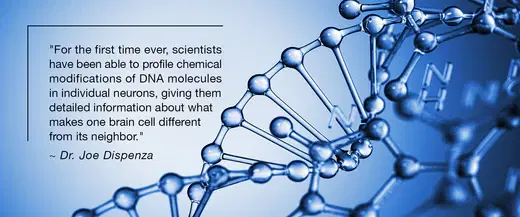What's the Gray in our Gray Matter?
Dr Joe Dispenza | 23 August 2017
When we lose our curiosity and get caught in the same patterns of thinking and feeling—whether we’re talking about the brain, the body, or even reality—we tend to think what we know is what is. But as human beings make new discoveries and realize we don’t know everything, our construct of understanding causes us to think differently, and as a result, we change our scientific model. Such is the case with new research coming out of the Salk Institute and the University of California San Diego.
We’ve known for some time that brain cells that store and process information are called neurons. From the viewpoint of a microscope, it can be hard to tell the difference between them. But now, for the first time ever, scientists have been able to profile chemical modifications of DNA molecules in individual neurons, giving them detailed information about what makes one brain cell different from its neighbor.
Using molecular methodologies and chemical markers, scientists have been able to identify groups of neurons with different functions, and from there they’ve been able to sort the neurons into subtypes. Up until now, scientists have not been able to determine how many types of neurons exist, but this new discovery could provide radical new insights into brain development and dysfunction. Using each cell’s methylome–the pattern of chemical markers made up of methyl groups that stud its DNA–the Salk team was able to sort neurons into subtypes.
“We think it’s pretty striking that we can tease apart a brain into individual cells, sequence their methylomes, and identify many new cell types along with their gene regulatory elements, the genetic switches that make these neurons distinct from each other,” says co-senior author Joseph Ecker, professor and director of Salk’s Genomic Analysis Laboratory and an investigator of the Howard Hughes Medical Institute.
RNA is a nucleic acid present in all living cells and its job is to act as a messenger to carry instructions from DNA for controlling the synthesis of proteins—the building blocks of life. Previously, researchers used RNA molecules inside individual brain cells to identify what sets them apart. This often proved inconclusive, however, because RNA levels can quickly change when exposed to new conditions, or even throughout the day. Instead, the Salk team turned to the generally stable cells’ methylomes, which usually remain stable throughout adulthood.
“Our research shows that we can clearly define neuronal types based on their methylomes,” says Margarita Behrens, a Salk senior staff-scientist and co-senior author of the new paper. “This opens up the possibility of understanding what makes two neurons–that sit in the same brain region and otherwise look similar–behave differently.”
Focusing on the frontal cortex, the area of the brain responsible for focused concentration, complex thinking, personality, social behaviors, and decision making, among other things, the team began their work on both mouse and human brains. In doing so, they were table to isolate 3,377 neurons from the frontal cortex of mice and 2,784 neurons from the frontal cortex of a deceased 25-year-old human.
Unlike other cells in the body, neurons have two types of methylation, so researchers were able to sequence the methylomes of each cell using new methods. What they discovered is that neurons from the mouse frontal cortex could be organized into 16 subtypes based on methylation patterns, while neurons from the human frontal cortex were more diverse and formed 21 subtypes. Results showed that neurons that provided stop messages in the brain (inhibitory neurons) showed more conserved methylation patterns between mice and humans compared to excitatory neurons. New unique human neuron subtypes were also identified in the study, further opening the door to the understanding of what sets us apart from animals.
“This study opens a new window into the incredible diversity of brain cells,” says Eran Mukamel of the UC San Diego Department of Cognitive Science, a co-senior author of the work.
The next step for researchers is to expand their study to look at additional parts of the brain, as well as more brains.
“There are hundreds, if not thousands, of types of brain cells that have different functions and behaviors and it’s important to know what all these types are to understand how the brain works,” says Chongyuan Luo, a Salk research associate and co-first author of the new paper, along with UC San Diego graduate student Christopher Keown. “Our goal is to create a parts list of both mouse and human brains.”
Once that “parts list” is complete, Ecker says they’d also like to begin studying whether the methylomes of neurons in people with brain diseases are different than those from healthy people. “If there’s a defect in just one percent of cells, we should be able to see it with this method,” he says. “Until now, we would have had no chance of picking something up in that small a percentage of cells.”
Even today, in our egocentric way of thinking we tend to think we know everything about the brain and the body, yet in reality our understanding is just a limited version. In time, we’ll continue to arrive at even greater understandings. Who knows where will be in our understanding about the complexity of the human brain 100 years from today. Now that’s evolution.

Comments